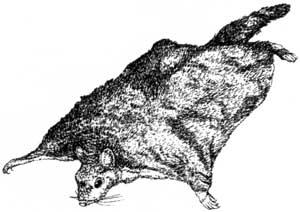A Furry Encounter of the Close Kind
It was an unusually quiet morning. Most of the previous winter’s snowpack had melted by the time summer began to reach its mid point. My family slept as I descended the stairs of a stone house at Park Headquarters to begin preparing for another day of assisting visitors. Little did I realize my first assistance that day would be to a rarely seen forest animal who had shown up, unannounced, for breakfast. As my foot touched the bare floor, a shiver went through my spine when a scrambling sound came from the kitchen. I realized then that I was not alone.
Upon tip toeing into the kitchen, I spotted a streaking ball of fur clamber up the kitchen cabinets. It headed for the early morning light of the window above the sink, apparently expecting to gain its freedom. The glass, however, stopped the creature’s hurried retreat. After realizing there was no escape, the animal then turned to face me. At that moment I saw its huge eyes, ones I will never forget. As I looked at the frightened animal, I recognized a frightened Cascade flying squirrel (Glaucomys sabrinus).Thankfully, the tingling in my spine quieted once I knew the source of those strange early morning noises.
 Drawing by Larry Eifert, The Distinctive Qualities of Redwoods, 1993, p. 37. |
I now wondered how the squirrel gained entry to our house. This nocturnal explorer, I then surmised, fell down our chimney while swinging from the bough of an overhanging mountain hemlock (Tsuga mertensiana). As it cowered on the kitchen window sill, I examined the squirrel. Brownish-gray fir, somewhat wispy, covered a diminutive body. It had a short, rounded nose and huge, unblinking eyes. The latter were obviously “better to see you with, my dear” at night.
Word of our furry visitor spread quickly among park staff, resulting in a steady stream of visitors parading through our house for the greater part of the day, all wanting to take a peek at one of nature’s most secretive and elusive creatures. The squirrel never seemed to blink all day, nor show any sign of sleeping. It never attempted to leave the safety of its narrow perch near the window. With darkness approaching, however, it was time to return the squirrel to the old growth forest. As we held the door open, the furry bundle began to stir and was soon scampering into the darkness.
That was 1973…
Almost 25 years later, while driving to Rim Village in March, I spotted what looked like a tiny Russian winter fur cap with ear flap lying in the middle of the road. As I pulled to a stop to pick up what I thought was a discarded piece of protective clothing about a half mile above Park Headquarters, I realized it was not at all what I had imagined. The brownish-gray “hat” was quivering and its “flaps” were rythmatically moving in and out. It was then I realized that I had found some type of small squirrel hunkered down on the packed snow. A bushy tail was thrust full length under its body and extended enough to cover a tiny face. What I witnessed, of course, amounted to survival behavior designed to keep the animal from freezing. As I hurriedly climbed out of my vehicle to take a photograph, the squirrel’s tail fell away from its face. This motion revealed its eyes, the same ones I remembered seeing in 1973!
As I approached the little ball of quivering fur, it suddenly darted for the top of my rear tire. This provided a nice level for a photo or two, but I wondered why it was not hibernating at this time of year. By gently rocking my vehicle back and forth after taking some pictures, I was able to frighten the squirrel from my tire and off it ran. As the flying squirrel was lost from view, I could only wonder about the hardships it faced during the next three months of winter. As I contemplated the danger posed by Pacific marten (Martes caurina) who prowl daily for small mammals, I could only hope that the flying squirrel might find the relative safety of a stone house — just as his ancestor did so long ago…
Larry Smith teaches school in Jacksonville, Oregon, and volunteers with the Friends of Crater Lake National Park. He worked as a seasonal employee in the park between 1961 and 1985.

